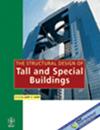框架-偏心核心筒结构水平变形及施工分析
IF 1.3
3区 工程技术
Q3 CONSTRUCTION & BUILDING TECHNOLOGY
引用次数: 1
摘要
由于混凝土的蠕变和收缩,结构的长期变形是超高层结构研究的热点之一。对于框架-偏心心筒结构,其长期变形包括垂直变形和明显的水平变形,这将不可避免地影响结构的垂直度。本文研究了框架-偏心心筒结构的水平变形及其形成机理。基于有限元软件ETABS,在现有结构的基础上,结合混凝土的时变材料模型,建立了一个精细的有限元模型。根据施工实际情况,进行了施工分析,并对施工变形和竣工后的长期变形进行了研究。根据施工分析结果,分析了弹性模量、蠕变和收缩对结构水平变形的影响;并对不同时期不同结构构件的水平变形特性进行了比较。结果表明,构件的水平变形与竖向变形有关,蠕变和收缩对结构的水平变形产生相反的影响。蠕变和收缩是后期水平变形的主导因素。这些结果得到了施工过程中实时变形监测的真实变形数据的支持,证明了本文所采用方法的有效性。本文章由计算机程序翻译,如有差异,请以英文原文为准。
Horizontal deformation and construction analysis of frame–eccentrical core tube structure
Due to creep and shrinkage of concrete, the long‐term structural deformation is one of the hottest topics in the study of super high‐rise structures. For the frame–eccentrical core tube structure, its long‐term deformation includes both vertical deformation and obvious horizontal deformation, which will have an inevitable influence on the structural verticality. The horizontal deformation and its formation mechanism in frame–eccentrical core tube structure are studied in this paper. Based on the finite element software ETABS, a refined finite element model combining with the time‐dependent material model of concrete is established base on a subsistent structure. According to the actual construction conditions, construction analysis is conducted, and the construction deformation and the long‐term deformation after completion are subsequently studied. Based on the results of construction analysis, the effects of elastic modulus, creep, and shrinkage on structural horizontal deformation are analyzed; furthermore, the horizontal deformation characteristics of different structural members in different periods are compared. The results show that the horizontal deformation is related to the vertical deformation of the component, and creep and shrinkage exert opposite effects on the structural horizontal deformation. Besides, the creep and shrinkage are the dominant factors of the horizontal deformation in the later stage. These results are supported by real deformation data obtained from real‐time deformation monitoring during construction, which proves the effectiveness of the method adopted in this paper.
求助全文
通过发布文献求助,成功后即可免费获取论文全文。
去求助
来源期刊
CiteScore
5.30
自引率
4.20%
发文量
83
审稿时长
6-12 weeks
期刊介绍:
The Structural Design of Tall and Special Buildings provides structural engineers and contractors with a detailed written presentation of innovative structural engineering and construction practices for tall and special buildings. It also presents applied research on new materials or analysis methods that can directly benefit structural engineers involved in the design of tall and special buildings. The editor''s policy is to maintain a reasonable balance between papers from design engineers and from research workers so that the Journal will be useful to both groups. The problems in this field and their solutions are international in character and require a knowledge of several traditional disciplines and the Journal will reflect this.
The main subject of the Journal is the structural design and construction of tall and special buildings. The basic definition of a tall building, in the context of the Journal audience, is a structure that is equal to or greater than 50 meters (165 feet) in height, or 14 stories or greater. A special building is one with unique architectural or structural characteristics.
However, manuscripts dealing with chimneys, water towers, silos, cooling towers, and pools will generally not be considered for review. The journal will present papers on new innovative structural systems, materials and methods of analysis.

 求助内容:
求助内容: 应助结果提醒方式:
应助结果提醒方式:


